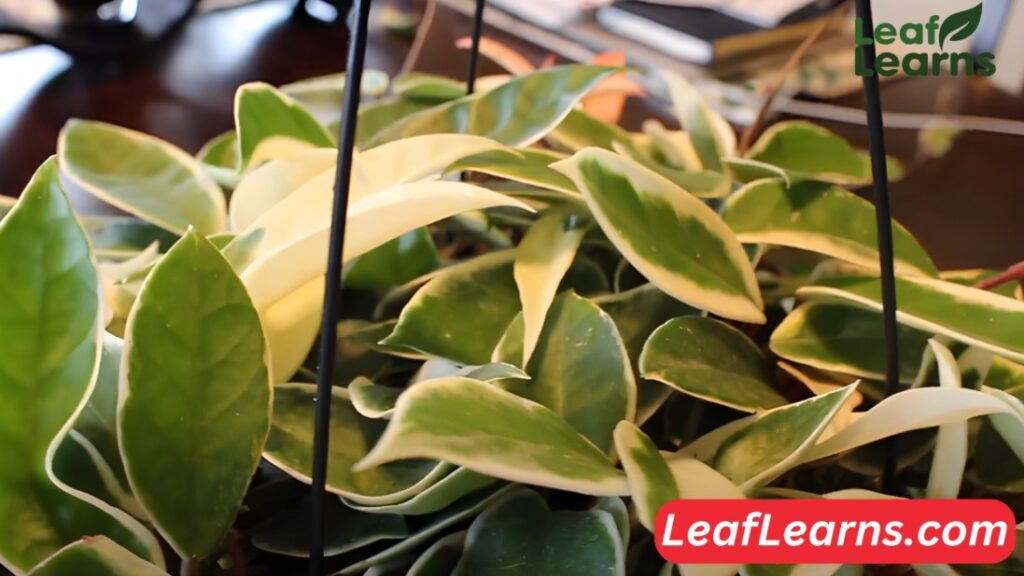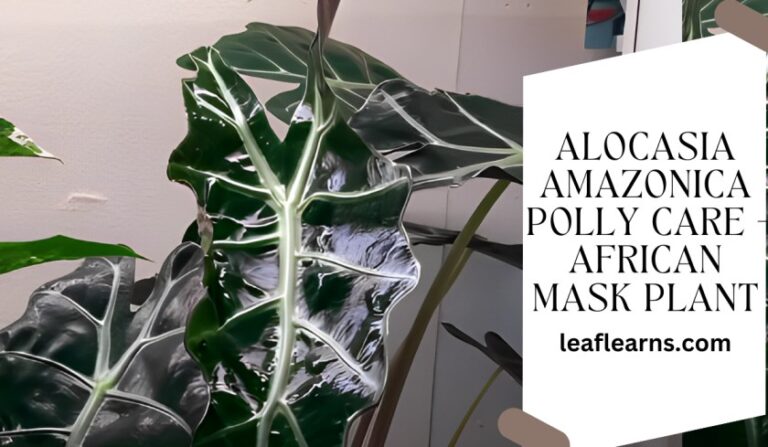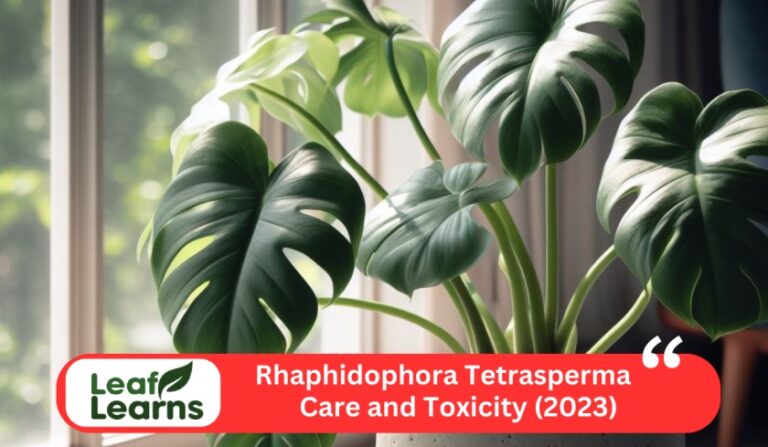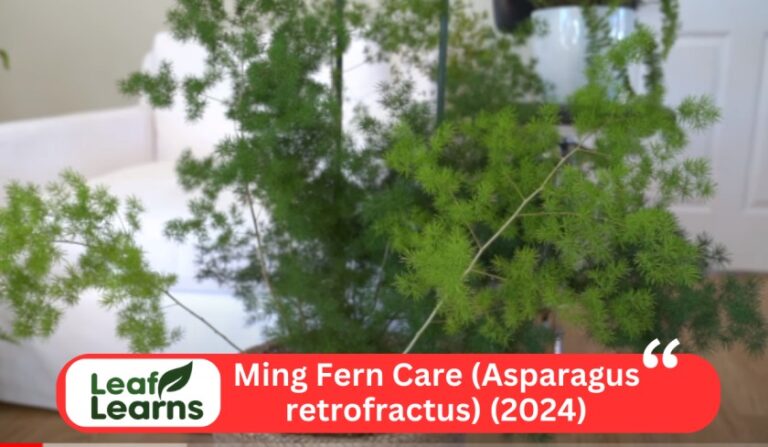Hoya Tricolor Care Guide (Carnosa variegata) 2024
The Wax plant or the Hoya tricolor care means it does well in bright indirect light and in well-drained soil. Water moderately so that the top inch of the soil has time to dry before watering again. Maintain temperatures between 60-80°F (15-27°C) and high humidity.

Periodic pruning promotes lush growth and helps with blossoming. Fertilize in moderation during the growing season. Protect from drafts and harsh temperatures. Replant every 2-3 years to refresh the soil and enhance the growth.
| Common Name | Wax Plant, Wax vine, Porcelain Flower |
| Scientific Name | Hoya carnosa ‘Tricolor’ |
| Family | Apocynaceae |
| Origin | Asia, Australia |
| Size | Up to 4 feet tall |
| Flower | Pink, white, green |
| Light | Bright indirect light |
| Water | Allow soil to dry slightly between waterings |
| Soil | Well-draining, aerated potting mix |
| Temperature | 60-80°F (15-27°C) |
| Humidity | Moderate to high |
| USDA Zone | 10-11 |
| Fertilizer | Balanced liquid fertilizer during the growing season |
| Pests | Mealybugs, aphids |
| Toxicity | Mildly toxic to pets if ingested |
Contents
Hoya tricolor Care
How much light does a Hoya tricolor need?
Imagine soft sunshine, not blinding heat. For your Hoya, bright, indirect light is essential. Windows facing east or west provide ideal lighting.
Steer clear of the intense noon heat as it might cause leaf burn. Although it can withstand less light, slower growth, and less colorful leaves are to be expected.
Recall that the preservation of its breathtaking variation depends on steady lighting conditions.
Hoya tricolor Care watering
Hoya tricolour is a succulent that does best with “deep and infrequent” watering. In between waterings, let the soil dry fully. Insert your finger into the pot to check the moisture content.
As overwatering might result in root rot, it is strongly discouraged. Cut back on watering even more in the winter.
What type of soil is best for Hoya tricolor?
It is essential for your Hoya to have well-draining soil. Choose a cactus and succulent mix, or make your own by adding pumice or perlite to ordinary potting mix to improve drainage.
Temperature Requirement
Your Hoya deserves a cozy sanctuary. The ideal temperature range is 68–80°F (20–27°C). Keep your plant safe from abrupt temperature decreases and stay away from draughty areas.
Although it can withstand certain temperature variations, ideal development is promoted by steady temperatures.
Do Hoya tricolor like humidity?
For your Hoya, moderate to high humidity is paradise. Combine it with other plants that thrive in humidity, use a humidifier, or use pebble trays filled with water to create a small-scale microclimate.
How often should I fertilize my Hoya tricolor plant?
A modest feeding every two to four weeks in the spring and summer, using a balanced fertilizer diluted to half strength, will make all the difference.
Recall that when it comes to fertilizing, less is more. Throughout the autumn and winter, completely stop fertilizing your Hoya to allow it to rest and recover.
Potting Requirement
Repot Hoya tricolor only when the roots completely cover the existing pot, since it prefers to be a little root-bound.
Choose a pot that is somewhat bigger than the last one and has drainage holes. Select the well-draining potting mix that was previously suggested. Repotting should not be done in the winter or when the plant is in bloom. So it it imporatant to understand the Hoya Tricolor Care.
How do you repot a Hoya tricolor?
- When your Hoya tricolour outgrows its present habitat, it may require a repotting journey, much like a prize worthy of a larger chest. When development is most vigorous, which is usually early spring to summer, is the ideal period for this voyage. This is your road map:
- Pay Attention to the Signs: Check for pots that are bulging at the seams or roots showing through drainage holes. Lift the plant cautiously if you’re not sure.
- Select Carefully: Choose a pot that is only one or two inches bigger and has enough drainage. Terracotta or plastic are good options.
- Get the Mix Ready: Create a mixture that drains easily. For ideal drainage, use one part potting mix to two parts perlite or pumice.
- Carefully unpot: Loosen any firmly connected roots by gently tugging the plant out.
- Fresh Starts: After setting the plant in the new pot, add mix.
Growth Rate and Size
Consider your Hoya tricolour as a careful artist who takes its time crafting a work of art. It grows at a moderate rate; in perfect circumstances, it adds 6 to 8 inches annually.
It may grow to a magnificent height of three to 5 feet and spread out, cascading wonderfully, with the right care.
Hoya Tricolor Flowers
Usually in late spring or early summer, clusters of star-shaped, delightfully scented flowers appear on the Hoya tricolor. Don’t overwater and use strong, indirect lighting to promote this spectacle.
It takes time for some plants to grow and blossom; thus, patience is essential.

Common Pests and Diseases
While generally resilient, your Hoya tricolor might encounter some foes:
- Pests: Look out for spider mites, aphids, and mealybugs. Your natural allies may be insecticidal soap or neem oil.
- Diseases: Root rot and fungus gnats might result from over-irrigation. Avoid damp soil and make sure the drainage is adequate.
Toxicity
Hoya tricolor is non toxic to Human. Although eating any plant is typically not advised, there is no known danger associated with this particular beauty. But it’s crucial to remember this:
- Swallowed food may result in little discomfort: Even non-toxic plants can cause upset stomach or vomiting if consumed, particularly in small children or animals.
- Individual sensitivities: Some people might experience allergic responses to even non-toxic plants. Direct contact with the sap or latex should be avoided, especially if the skin is sensitive.
Is Hoya tricolor toxic to cats and pets?
The good news for those who are inquisitive about owning pets is that Hoya tricolor is non toxic for cats and other animals! This indicates that it is unlikely to be harmful to consume small amounts of the plant’s leaves or other parts.
The Importance of Tailored Hoya tricolor Care
Caring for Hoya plants, including the vibrant Hoya tricolor, requires attention to detail and a commitment to their specific needs. When it comes to hoya tricolor care, enthusiasts must understand the nuances of their care, whether it’s labeled as “hoya tricolor pflege” in German or “hoya tricolor care bear” humorously.
Variants like the “hoya exotica carnosa tricolor” demand specialized attention, as do the “hoya carn tricolor” and “hoya tricolor carnosa krimson queen variegated,” each with its unique requirements. A comprehensive understanding of “how to care for hoya tricolor” involves considering factors like watering schedules, sunlight exposure, and soil conditions.
Similarly, for “hoya carnosa care,” including the compacta, chelsea, and splash varieties, attention to detail is paramount, especially when navigating instructions for “hoya carnosa care indoor” or “hoya carnosa care uk.” Meanwhile, “hoya wayetii tricolor care” and “hoya australis tricolor care” underscore the need for tailored care based on species.
General guidelines for hoya care, encompassing watering frequency and growth rates, are essential for maintaining overall plant health. With proper care instructions and knowledge of each hoya’s unique needs, enthusiasts can enjoy the lasting beauty of hoya flowers, whether it’s the tricolor’s delicate hues or the vibrant blooms of other varieties like the tri color hoya carnosa.
FAQs
How often do you water Hoya tricolor?
When the soil dries completely, water deeply to simulate its succulent texture. You may change this dependent on light, temperature, and humidity, perhaps every one to two weeks.
Is Tricolor Hoya rare?
While not very uncommon, it is less frequent than the typical Hoya carnosa. It is more in demand because of its gorgeous tricolor leaves
Why is my Hoya tricolor not growing?
A lack of light, overwatering, underwatering, nutrient shortage, or root issues are a few possible causes. Examine every element and modify your care as necessary.
Does Hoya tricolor bloom?
Yes, from late spring to summer, it yields clusters of fragrant star-shaped blooms. Proper light, temperature, and maturity (2-3 years) are crucial to fostering flowers.
What is the best soil for Hoya tricolor?
Use a well-draining mix like:
- 1 part perlite or pumice
- 2 parts potting mix
- This ensures excess water drains easily, preventing root rot.
What is Hoya tricolor?
The leaves of this gorgeous climbing vine are variegated in shades of pink, cream, and green. Well-liked as a houseplant, it has fragrant blossoms and is said to cleanse the air.
Is Hoya carnosa an indoor plant?
Yes, both Hoya carnosa and its Tricolor variation thrive as indoor plants with proper care.
Is Hoya tricolor the same as Krimson Princess?
No, despite their similarities, they are different kinds. Compared to Tricolor, which has softer pink and cream tones in its leaves, Krimson Princess has deeper pink and red tones.



